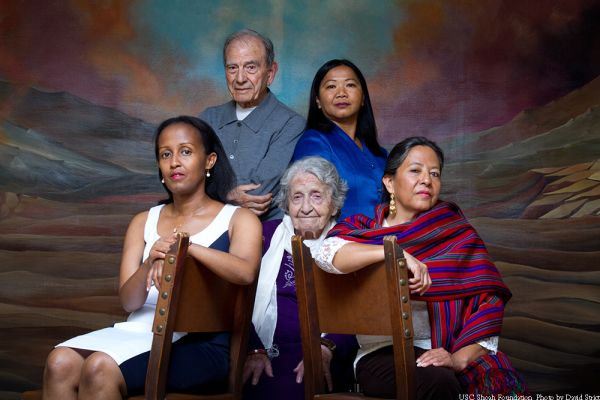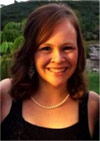Teaching with Testimony for Genocide Awareness Month

Throughout history, April has unfortunately been a significant month in the planning and implementation of genocide. In April 1915, the Ottoman government rounded up and arrested Armenian intellectuals – the first step in the Armenian Genocide. Less than 20 years later, in April 1933, the Nazis implemented several measures restricting the rights of Jews in Germany. In 1975, the Khmer Rouge captured Phnom Penh in Cambodia and massacred over 1 million people over four years. And in April 1994, an airplane carrying the president of Rwanda was shot down by a surface-to-air missile as it was about to land in Kigali airport – igniting the 1994 Genocide against the Tutsi in Rwanda.
That’s why it’s fitting for April to be designated as Genocide Awareness Month. Many educators use this time to teach about different genocides throughout history. However, it can seem overwhelming to teach about something as complex and difficult as genocide, while making it relatable to students. During a recent #IWitnessChat – moderated by USC Shoah Foundation’s educational platform IWitness with guest host Facing History and Ourselves – teachers from across the United States shared how they use testimony to commemorate and teach about the Holocaust and genocide in their classrooms.
Explore the below tips from educators on how to use testimony to commemorate Genocide Awareness Month and introduce the topic of genocide in your classroom.
Click here to register for IWitness
1. Introducing testimony into your curriculum
Testimony helps provides a human face to the past, engages students to critically think about universal themes of tolerance, diversity and justice from an individual perspective. Testimony can be used across disciplines from history to geography and even in Language Arts.
- Teaching World Geography I strive to find testimony and voice for every topic we study.
- Holocaust, slavery, women's rights. Testimony can be used for almost any unit as a powerful tool.
- 10th grade has many possible topics to integrate testimony into literature including Of Mice and Men, Lord of the Flies, Animal Farm, Night.
- Testimony can be integrated into Native American Studies (present day and historical), Japanese American incarceration and civil rights.
- Testimony helps make historical figures and survivors real for middle school students--not just words on a page.
Tip: Integrate testimony into your curriculum with curated clips from the Watch Page from over 50 various topics. Learn best practices for teaching with testimony, download the guide Using Visual Testimony in the Classroom.
2. How to introduce the topic and history genocide into your classroom
It is important to create context about the time, place and culture surrounding the events described by interviewees, and share this information with students. This context will help students more fully understand and appreciate the interviewee’s motivations, choices and actions, as well as those of the people around him/her.
- For the Holocaust, I start with teaching rise of Hitler, historical antisemitism, forced marginalization and then the Final Solution. It is important to teach the stages of genocide.
- I use the pyramid of hate, which lists the steps beginning with prejudiced attitudes, acts of prejudice, discrimination and then violence, which lead to genocide and genocide denial.
Tip: Register free in IWitness and use the Connection Videos available in the educator dashboard. Connection Videos provide context and historical information on several different genocides and themes.
3. Teaching themes across disciplines
Use testimony to teach different themes like propaganda, resistance, discrimination, to courage.
- I teach 7th grade so I start with building empathy and a sense of global civic responsibility.
- Examining propaganda is a good way to connect feelings of prejudice with actions of discrimination
- We look at propaganda for evidence of author bias and discrimination to show how prejudice and hate builds up to action.
- Testimony on the topic of courage appeals to middle school students.
Tip: Browse the Activity Library for multimedia activities that focus on an array topics, themes and subject areas.
4. The impact of teaching with testimony
Educators share how teaching with testimony is powerful experience for their students and themselves.
- Testimony helps students see how lives are impacted by genocide, beyond number killed.
- Testimony helps students understand that genocide doesn't happen to faceless masses, it happens to individuals.
- Firsthand accounts are always so important. Difficult to look someone in the eye & deny what happened to them.
- Testimony humanizes history and helps students empathize. Shows how an executive order, law, or action affects "real" people.
- Testimony provides the background knowledge for students to see the influence and effects of policies.
- Too often genocide is spoken about in numbers, not people. Testimony helps humanize those who have been dehumanized.
- Words don't reveal facial expression or emotion. These things change story and understanding. Essential to build empathy.
- Testimony helps students learn genocide is aimed at a group but the group is made up of individuals.
- So much about genocide is new to most of my students. Though they learn how important it is to be up standers and resist hatred.
- Genocide testimony helps focus on how we can be up standers in our daily lives. Students feel empowered instead of helpless.
Tip: Share how testimony inspires you and your students on social media with #BeginsWithMe.
